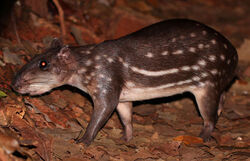| Lowland Paca | |
|---|---|
 | |
| Information | |
| Common Name | Spotted Paca |
| Range | tropical and sub-tropical America, from East-Central Mexico to Northern Argentina. |
| Scientific Classification | |
| Kingdom | Animalia |
| Phylum | Chordata |
| Class | Mammalia |
| Order | Rodentia |
| Family | Cuniculidae |
| Genus | Cuniculus |
| Species | Cuniculus paca |
| Conservation Status | |
 Least Concern | |
The Lowland paca (Cuniculus paca), also known as the spotted paca, is a species of paca found in tropical and sub-tropical America, from East-Central Mexico to Northern Argentina. It is called paca in most of its range, but tepezcuintle in most of Mexico and Central America, pisquinte in northern Costa Rica, jaleb in the Yucatán peninsula, conejo pintado in Panamá, guanta in Ecuador, majás or picuro in Peru, jochi pintado in Bolivia, and boruga or guardatinaja in Colombia. It is also known as the gibnut in Belize, where it is prized as a game animal, labba in Guyana, lapa in Venezuela, and lappe on the island of Trinidad.
There is much confusion in the nomenclature of this and related species; see agouti. In particular, the popular term agouti or common agouti normally refers to species of the distinct Dasyprocta genus. Sometimes the word agouti is also used for a polyphyletic grouping uniting the families Cuniculidae and Dasyproctidae, which, besides the pacas and common agoutis, includes also the acouchis. Cuniculus is the appropriate genus name instead of Agouti based on a 1998 ruling of the International Commission on Zoological Nomenclature as the Lowland Paca's genus.
Etymology[]
The word "paca" comes from a word in the Tupi language that designates the animal but also means "awaken, alert." "Tepezcuintle" is of Nahuatl origin, meaning mountain dog: tepetl = mountain; itzquintli = dog.
Description[]
The lowland paca has coarse fur without underfur, dark brown to black on the upper body and white or yellowish on the underbelly. It usually has three to five rows of white spots along its sides, against a dark grey background. It has thick strong legs, with four digits in the forefeet and five in the hind feet (the first and fifth are reduced); the nails function as hooves. The tail is short and hairless. The zygomatic arch is expanded laterally and dorsally and is used as a resonating chamber - a unique feature among mammals.
Habits[]
The lowland paca is mostly nocturnal and solitary and does not vocalize very much. It lives in forested habitats near water, preferably smaller rivers, and dig simple burrows about 2 m (6 ft 7 in) below the surface, usually with more than one exit. The lowland paca is a good swimmer and usually heads for the water to escape danger. It also is an incredible climber and it searches for fruit in the trees. Its diet includes leaves, stems, roots, seeds, and fruit, especially avocados, mangos and zapotes. It sometimes stores food.
Economical and Ecological Aspects[]
The lowland paca is considered an agricultural pest for yam, cassava, sugar cane, corn and other food crops. Its meat is highly prized. It is plentiful in protected habitats, and hence not in danger of extinction, but overall its numbers have been much reduced because of hunting and habitat destruction. It is easily bred and raised in farms, although the taste is said to be inferior (perhaps unpleasant) when farmed.
